Effect of Cr, Mo, and V Elements on the Microstructure and Thermal Fatigue Properties of the Chromium Hot-Work Steels Processed by Selective Laser Melting
Abstract
:1. Introduction
2. Experimental Procedures
2.1. Materials
2.2. SLM Process
2.3. Experiments and Methods
3. Results
3.1. Phase Analysis
3.2. Crystallographic Features
3.3. Distributions of Grain Size
3.4. Coarse Laths
3.5. Tensile Properties
3.6. Thermal Fatigue Properties
4. Discussion
4.1. Effect of Alloying Elements on the Microstructures of the Chromium Hot-Work Steels Processed by SLM
- (1)
- (2)
- Block size. As presented earlier, the block size of MH decreased by approximately 1.13 μm (approximately 44.14% of the block size of LH) with the increase of Cr, Mo, and V contents. While the block size increased by approximately 0.29 μm with a further increase of Cr and Mo contents. Obviously, grain coarsening occurred with the increase of Cr and Mo in HH. Therefore, the increase in V contents should be the main reason for grain refinement in MH. This is coincident with the published theory that V could be added as a weak grain-refining element in steels [15].
- (3)
- Coarse laths. It is reported that coarse laths are softer than the surroundings since they experienced an auto temper process as they form earliest in the course of martensitic transformation [35]. According to the results of Section 3.3 and Section 3.4, we found that LH possessed the largest block size and the largest portion of coarse laths among the three materials, whereas MH possessed the smallest block size and the least portion of coarse laths. Consequently, it can be supposed that the content of coarse laths increased with the increase in block size.
4.2. Effect of the Microstructures and Mechanical Properties on the Thermal Fatigue Properties of the Chromium Hot-Work Steels Processed by SLM
- (1)
- Retained austenite. It is well accepted that retained austenite facilitates the toughness and ductility of steels [22]. The pileup occurs when dislocations move to the grain boundaries, which leads to stress concentration and crack initiation at the head of the pileup group. It was found that the moving resistance of the dislocations can be reduced by the coherent or semi-coherent interfaces (between the retained austenite and martensite matrix), and as a result, softens the materials and decreases the crack initiation and propagation rate [42]. Furthermore, the transformation of retained austenite to martensite can develop the compressive residual stress in the material, which can suppress crack initiation and growth [43]. However, retained austenite only functions at the early stage of TF tests since it decreases largely because of the heating and cooling process.
- (2)
- Grain size. It is known that the strength and toughness of martensitic steels can be improved as the grain size is refined [31]. This is because the high-angle-grain boundaries (boundaries of prior austenite, packets, and blocks) strengthened by dislocation pileup possess the ability to impede the propagation of cleavage crack [31]. Since the temperature for the TF test was much higher than for the Ms temperature, the fracture toughness should be estimated by the grain size of the prior austenite. As is shown in Figure 10, LH, HH, and MH revealed their prior austenite grain sizes in descending order.
- (3)
- Coarse laths. Coarse laths represent soft spots in martensite and therefore they plastically yield first, leading to the early plasticity activity and becoming prone to bulk or interface plasticity. The coarse laths interiors also show the pronounced slip activity, whereas less slip activity is observed in the neighboring thin laths [35].
5. Conclusions
- (1)
- All the as-built SLM-processed chromium hot-work steels exhibited the martensite and retained austenite structures. Retained austenite content increased with the increase of the alloying additions.
- (2)
- The average martensitic blocks size was approximately 2.56 μm, 1.43 μm, and 1.72 μm for LH, MH, and HH, respectively. That is because the increase of V led to grain refinement in MH, whereas the increase of Cr and Mo led to some grain coarsening in HH. The content of coarse laths and the KAM value increased with the increase in martensitic block sizes.
- (3)
- LH, MH, and HH possessed the UTS of 1218 ± 18 MPa, 1281 ± 19 MPa, and 1258 ± 22 MPa, and hardness of 528 ± 8 HV5, 597 ± 12 HV5, and 592 ± 9 HV5, respectively. All the materials experienced a secondary hardening process during TF tests, with the hardness of 573 ± 9 HV5, 688 ± 11 HV5, and 675 ± 10 HV5, respectively, after TF tests.
- (4)
- LH exhibited the longest crack length after TF tests, and HH exhibited the shortest. Grain refinement led to the increase in strength and enhancement of TF resistance in MH. Although the grain coarsening and strength decrease may facilitate the crack propagation in HH, the increase in the amount of coarse laths enhanced the TF resistance in the material. It is suggested that the grain size and the amount of coarse laths are the most important factors to determine the TF resistance of chromium hot-work steels that are processed by SLM.
Author Contributions
Funding
Institutional Review Board Statement
Informed Consent Statement
Data Availability Statement
Acknowledgments
Conflicts of Interest
References
- Huber, F.; Bischof, C.; Hentschel, O.; Heberle, J.; Zettl, J.; Nagulin, K.Y.; Schmidt, M. Laser beam melting and heat-treatment of 1.2343 (AISI H11) tool steel—Microstructure and mechanical properties. Mater. Sci. Eng. A 2019, 742, 109–115. [Google Scholar] [CrossRef]
- Kruth, J.-P.; Badrossamay, M.; Yasa, E.; Deckers, J.; Thijs, L.; Van Humbeeck, J. Part and material properties in selective laser melting of metals. In Proceedings of the 16th International Symposium on Electromachining, Shanghai, China, 19–23 April 2010. [Google Scholar]
- Holzweissig, M.J.; Taube, A.; Brenne, F.; Schaper, M.; Niendorf, T. Microstructural characterization and mechanical performance of hot work tool steel processed by selective laser melting. Metall. Mater. Trans. B 2015, 46, 545–549. [Google Scholar] [CrossRef]
- Wang, M.; Li, W.; Wu, Y.; Li, S.; Cai, C.; Wen, S.; Wei, Q.; Shi, Y.; Ye, F.; Chen, Z. High-Temperature Properties and Microstructural Stability of the AISI H13 Hot-Work Tool Steel Processed by Selective Laser Melting. Metall. Mater. Trans. B 2019, 50, 531–542. [Google Scholar] [CrossRef]
- ASM Handbook Committee. ASM Handbook—Volume 14: Forming and Forging; ASM International, Materials Park: Geauga, OH, USA, 1996; p. 70. [Google Scholar]
- Brooks, H.; Brigden, K. Design of conformal cooling layers with self-supporting lattices for additively manufactured tooling. Addit. Manuf. 2016, 11, 85–96. [Google Scholar] [CrossRef] [Green Version]
- Mertens, R.; Vrancken, B.; Holmstock, N.; Kinds, Y.; Kruth, J.-P.; Van Humbeeck, J. Influence of Powder Bed Preheating on Microstructure and Mechanical Properties of H13 Tool Steel SLM Parts. Phys. Procedia 2016, 83, 882–890. [Google Scholar] [CrossRef] [Green Version]
- AlMangour, B.; Grzesiak, D.; Yang, J.-M. Selective laser melting of TiB 2/H13 steel nanocomposites: Influence of hot isostatic pressing post-treatment. J. Mater. Processing Technol. 2017, 244, 344–353. [Google Scholar] [CrossRef]
- Wang, M.; Wu, Y.; Wei, Q.; Shi, Y. Thermal Fatigue Properties of H13 Hot-Work Tool Steels Processed by Selective Laser Melting. Metals 2020, 10, 116. [Google Scholar] [CrossRef] [Green Version]
- Harrison, N.J.; Todd, I.; Mumtaz, K. Reduction of micro-cracking in nickel superalloys processed by selective laser melting: A fundamental alloy design approach. Acta Mater. 2015, 94, 59–68. [Google Scholar] [CrossRef] [Green Version]
- Wu, W.; Hwu, L.Y.; Lin, D.Y.; Lee, J.L. The relationship between alloying elements and retained austenite in martensitic stainless steel welds. Scr. Mater. 2000, 42, 1071–1076. [Google Scholar] [CrossRef]
- Li, B.; Qian, B.; Xu, Y.; Liu, Z.; Zhang, J.; Xuan, F. Additive manufacturing of ultrafine-grained austenitic stainless steel matrix composite via vanadium carbide reinforcement addition and selective laser melting: Formation mechanism and strengthening effect. Mater. Sci. Eng. A 2019, 745, 495–508. [Google Scholar] [CrossRef]
- Jia, Q.; Rometsch, P.; Kürnsteiner, P.; Chao, Q.; Huang, A.; Weyland, M.; Bourgeois, L.; Wu, X. Selective laser melting of a high strength AlMnSc alloy: Alloy design and strengthening mechanisms. Acta Mater. 2019, 171, 108–118. [Google Scholar] [CrossRef]
- Medvedeva, A.; Bergström, J.; Gunnarsson, S.; Andersson, J. High-temperature properties and microstructural stability of hot-work tool steels. Mater. Sci. Eng. A 2009, 523, 39–46. [Google Scholar] [CrossRef]
- ASM Handbook Committee. ASM Handbook—Volume 1: Properties and Selection: Irons, Steels, and High Performance Alloys; ASM international, Materials Park: Geauga, OH, USA, 1996; pp. 320, 597, 601, 1025–1029, 1042, 1058, 1153–1029, 1770, 1785, 2203. [Google Scholar]
- Steels, H.S. ASM Handbook—Volume 1: Properties and Selection: Irons, Steels, and High Performance Alloys Section: Carbon and Low-alloy Steels; ASM International: Geauga, OH, USA, 2005; p. 10. [Google Scholar]
- Gwon, H.; Kim, J.-K.; Shin, S.; Cho, L.; De Cooman, B.C. The effect of vanadium micro-alloying on the microstructure and the tensile behavior of TWIP steel. Mater. Sci. Eng. A 2017, 696, 416–428. [Google Scholar] [CrossRef]
- Klobčar, D.; Tušek, J.; Taljat, B. Thermal fatigue of materials for die-casting tooling. Mater. Sci. Eng. A 2008, 472, 198–207. [Google Scholar] [CrossRef]
- ASM Handbook Committee. ASM Handbook—Volume 19: Fatigue and fracture; ASM International Materials Park: Geauga, OH, USA, 1996; Volume 1313, p. 1689. [Google Scholar]
- Mellouli, D.; Haddar, N.; Köster, A.; Ayedi, H.F. Hardness effect on thermal fatigue damage of hot-working tool steel. Eng. Fail. Anal. 2014, 45, 85–95. [Google Scholar] [CrossRef]
- Vetriselvan, R.; Sathiya, P.; Ravichandran, G. Experimental and numerical investigation on thermal fatigue behaviour of 9Cr 1Mo steel tubes. Eng. Fail. Anal. 2018, 84, 139–150. [Google Scholar] [CrossRef]
- Galindo-Nava, E.I.; Rivera-Díaz-del-Castillo, P.E.J. Understanding the factors controlling the hardness in martensitic steels. Scr. Mater. 2016, 110, 96–100. [Google Scholar] [CrossRef]
- Kitahara, H.; Ueji, R.; Tsuji, N.; Minamino, Y. Crystallographic features of lath martensite in low-carbon steel. Acta Mater. 2006, 54, 1279–1288. [Google Scholar] [CrossRef]
- Saeidi, K.; Gao, X.; Lofaj, F.; Kvetková, L.; Shen, Z.J. Transformation of austenite to duplex austenite-ferrite assembly in annealed stainless steel 316L consolidated by laser melting. J. Alloys Compd. 2015, 633, 463–469. [Google Scholar] [CrossRef]
- Li, W.; Li, S.; Liu, J.; Zhang, A.; Zhou, Y.; Wei, Q.; Yan, C.; Shi, Y. Effect of heat treatment on AlSi10Mg alloy fabricated by selective laser melting: Microstructure evolution, mechanical properties and fracture mechanism. Mater. Sci. Eng. A 2016, 663, 116–125. [Google Scholar] [CrossRef]
- Bhadeshia, H.; Honeycombe, R. Steels: Microstructure and Properties; Elsevier Ltd.: Oxford, UK, 2006; pp. 10–35, 96, 184, 195. [Google Scholar]
- Katancik, M.; Mirzababaei, S.; Ghayoor, M.; Pasebani, S. Selective laser melting and tempering of H13 tool steel for rapid tooling applications. J. Alloys Compd. 2020, 849, 156319. [Google Scholar] [CrossRef]
- Saeidi, K.; Gao, X.; Zhong, Y.; Shen, Z. Hardened austenite steel with columnar sub-grain structure formed by laser melting. Mater. Sci. Eng. A 2015, 625, 221–229. [Google Scholar] [CrossRef]
- Dilip, J.J.S.; Ram, G.D.J.; Starr, T.L.; Stucker, B. Selective laser melting of HY100 steel: Process parameters, microstructure and mechanical properties. Addit. Manuf. 2017, 13, 49–60. [Google Scholar] [CrossRef]
- Berecz, T.; Jenei, P.; Csóré, A.; Lábár, J.; Gubicza, J.; Szabó, P.J. Determination of dislocation density by electron backscatter diffraction and X-ray line profile analysis in ferrous lath martensite. Mater. Charact. 2016, 113, 117–124. [Google Scholar] [CrossRef]
- Li, S.; Zhu, G.; Kang, Y. Effect of substructure on mechanical properties and fracture behavior of lath martensite in 0.1C–1.1Si–1.7Mn steel. J. Alloys Compd. 2016, 675, 104–115. [Google Scholar] [CrossRef]
- Samek, L.; Moor, E.D.; Penning, J.; Cooman, B.C.D. Influence of alloying elements on the kinetics of strain-induced martensitic nucleation in low-alloy, multiphase high-strength steels. Metall. Mater. Trans. A 2006, 37, 109–124. [Google Scholar] [CrossRef]
- Xiong, X.; Hu, S.; Hu, K.; Zeng, S. Texture and magnetic property evolution of non-oriented Fe–Si steel due to mechanical cutting. J. Magn. Magn. Mater. 2016, 401, 982–990. [Google Scholar] [CrossRef]
- Morsdorf, L.; Tasan, C.C.; Ponge, D.; Raabe, D. 3D structural and atomic-scale analysis of lath martensite: Effect of the transformation sequence. Acta Mater. 2015, 95, 366–377. [Google Scholar] [CrossRef]
- Morsdorf, L.; Jeannin, O.; Barbier, D.; Mitsuhara, M.; Raabe, D.; Tasan, C.C. Multiple mechanisms of lath martensite plasticity. Acta Mater. 2016, 121, 202–214. [Google Scholar] [CrossRef]
- AlMangour, B.; Grzesiak, D.; Yang, J.-M. Nanocrystalline TiC-reinforced H13 steel matrix nanocomposites fabricated by selective laser melting. Mater. Des. 2016, 96, 150–161. [Google Scholar] [CrossRef]
- Mercelis, P.; Kruth, J.-P. Residual stresses in selective laser sintering and selective laser melting. Rapid Prototyp. J. 2006, 12, 254–265. [Google Scholar] [CrossRef]
- Jia, Z.-x.; Liu, Y.-w.; Li, J.-q.; Liu, L.-J.; Li, H.-l. Crack growth behavior at thermal fatigue of H13 tool steel processed by laser surface melting. Int. J. Fatigue 2015, 78, 61–71. [Google Scholar] [CrossRef]
- Smith, W.F.; Hashemi, J. Foundations of Materials Science and Engineering, 4th ed.; McGraw-Hill: New York, NY, USA, 2006. [Google Scholar]
- ASM Handbook Committee. ASM Handbook–Volume 4: Heat Treating; ASM International, Materials Park: Geauga, OH, USA, 1990; pp. 33, 22–24, 189. [Google Scholar]
- Stonesifer, F.R.; Armstrong, R.W. Effect of Prior Austenite Grain Size on the Fracture Toughness Properties of A533 B Steel; ICF4: Waterloo, ON, Canada, 1977. [Google Scholar]
- Hao, K.; Gong, M.; Pi, Y.; Zhang, C.; Gao, M.; Zeng, X. Effect of Ni content on rolling toughness of laser-arc hybrid welded martensitic stainless steel. J. Mater. Processing Technol. 2018, 251, 127–137. [Google Scholar] [CrossRef]
- Koyama, M.; Zhang, Z.; Wang, M.; Ponge, D.; Paabe, D.; Tsuzaki, K.; Noguchi, H.; Tasan, C.C. Bone-like crack resistance in hierarchical metastable nanolaminate steels. Science 2017, 355, 1055–1057. [Google Scholar] [CrossRef] [PubMed]

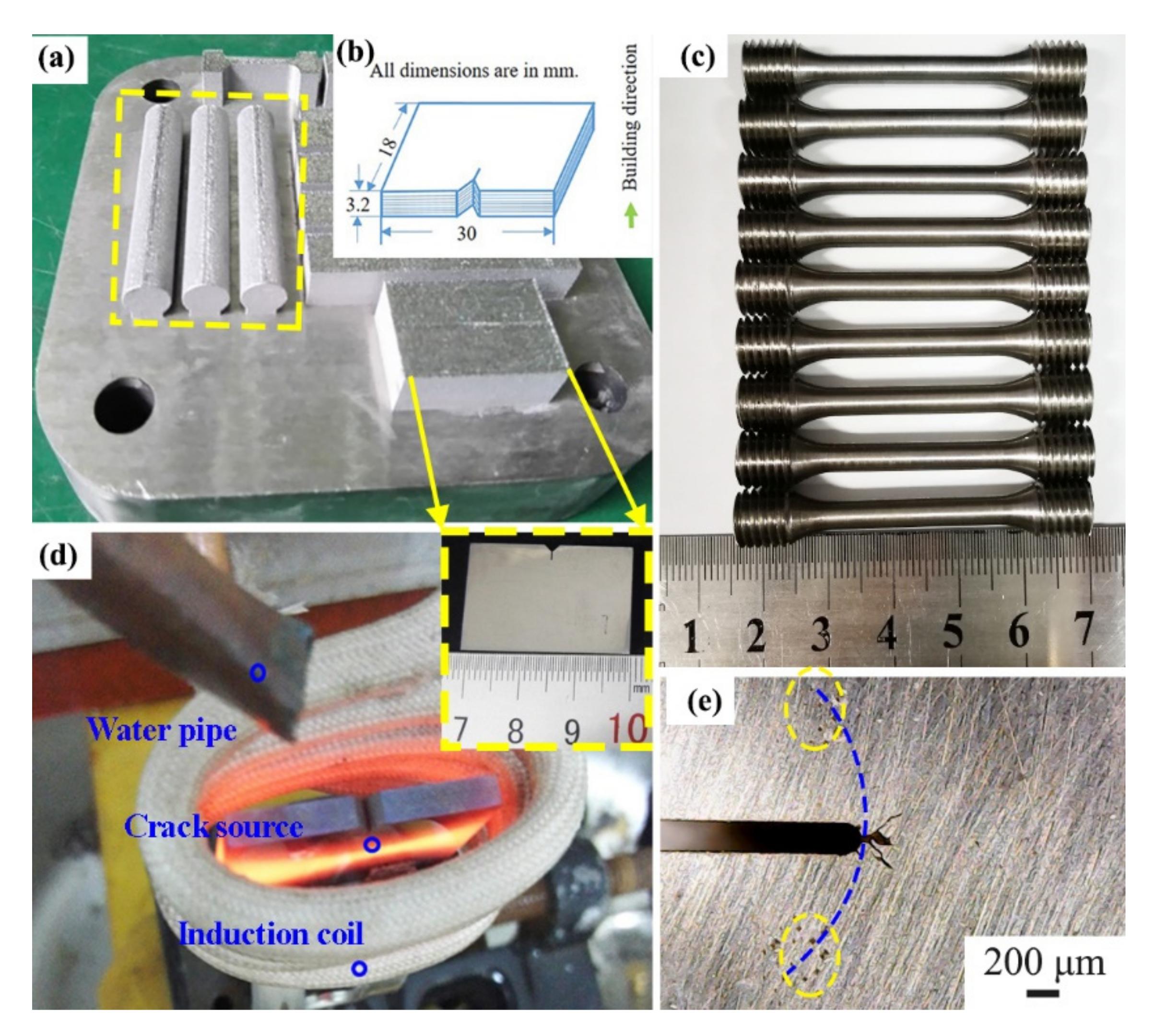
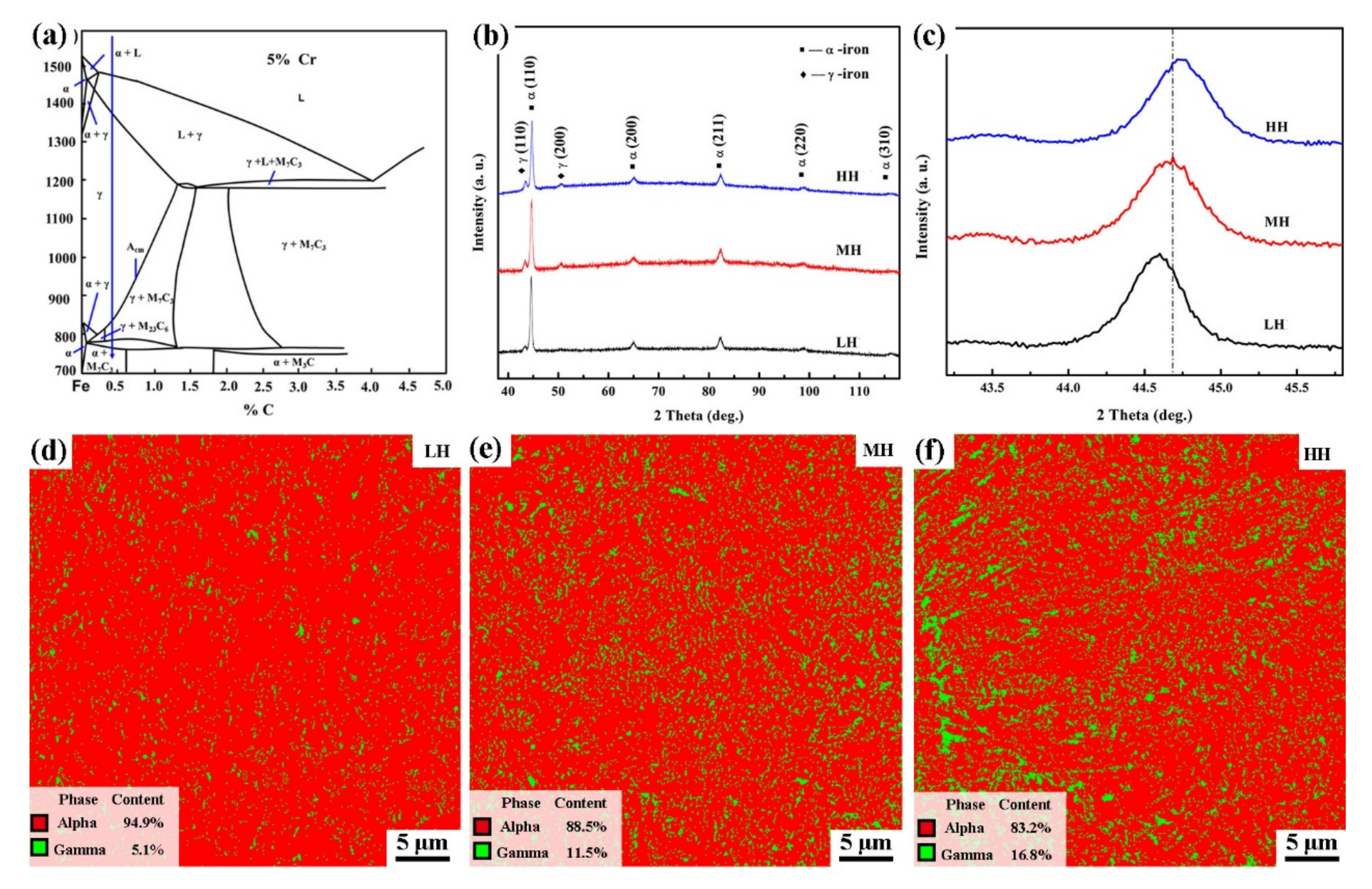
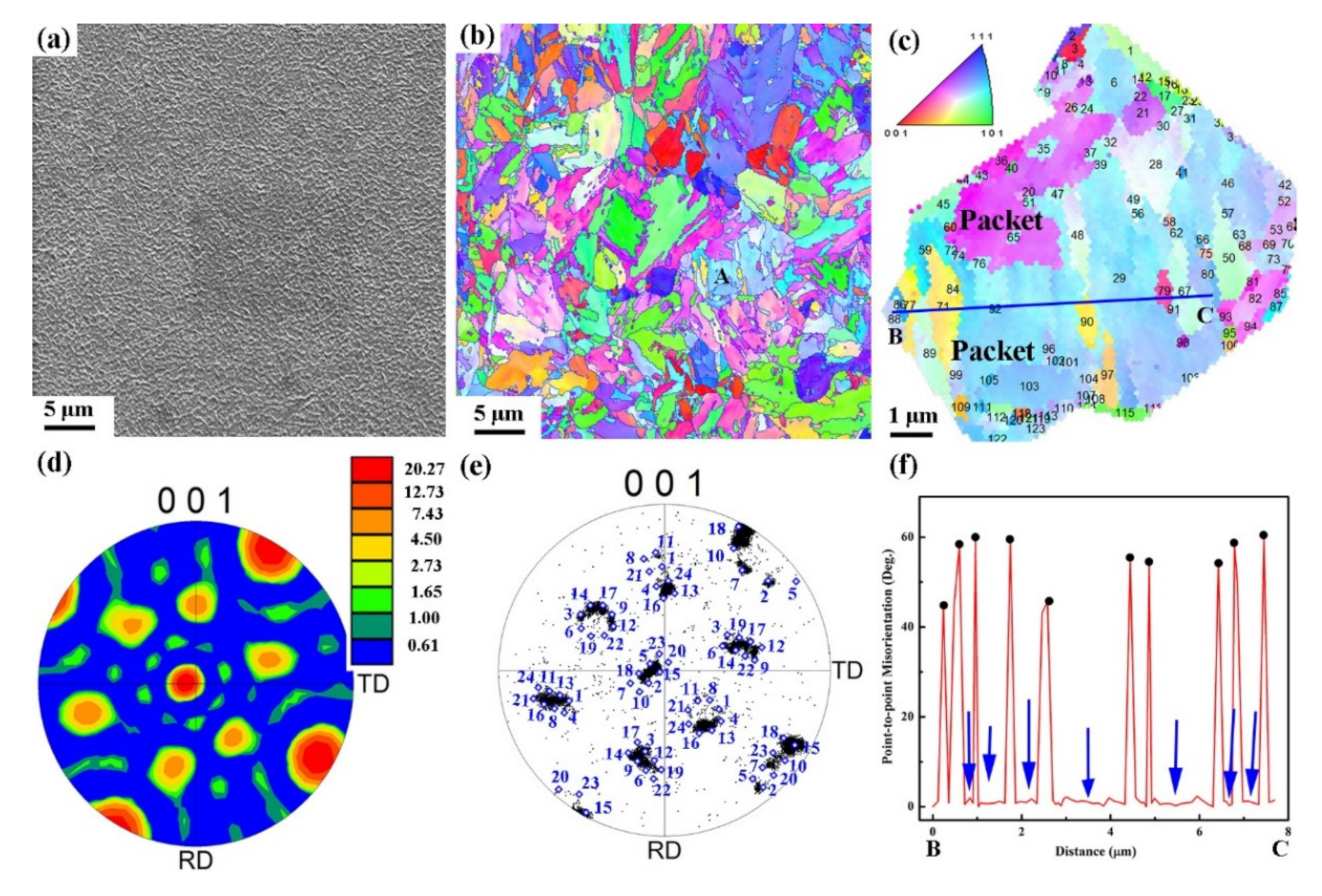

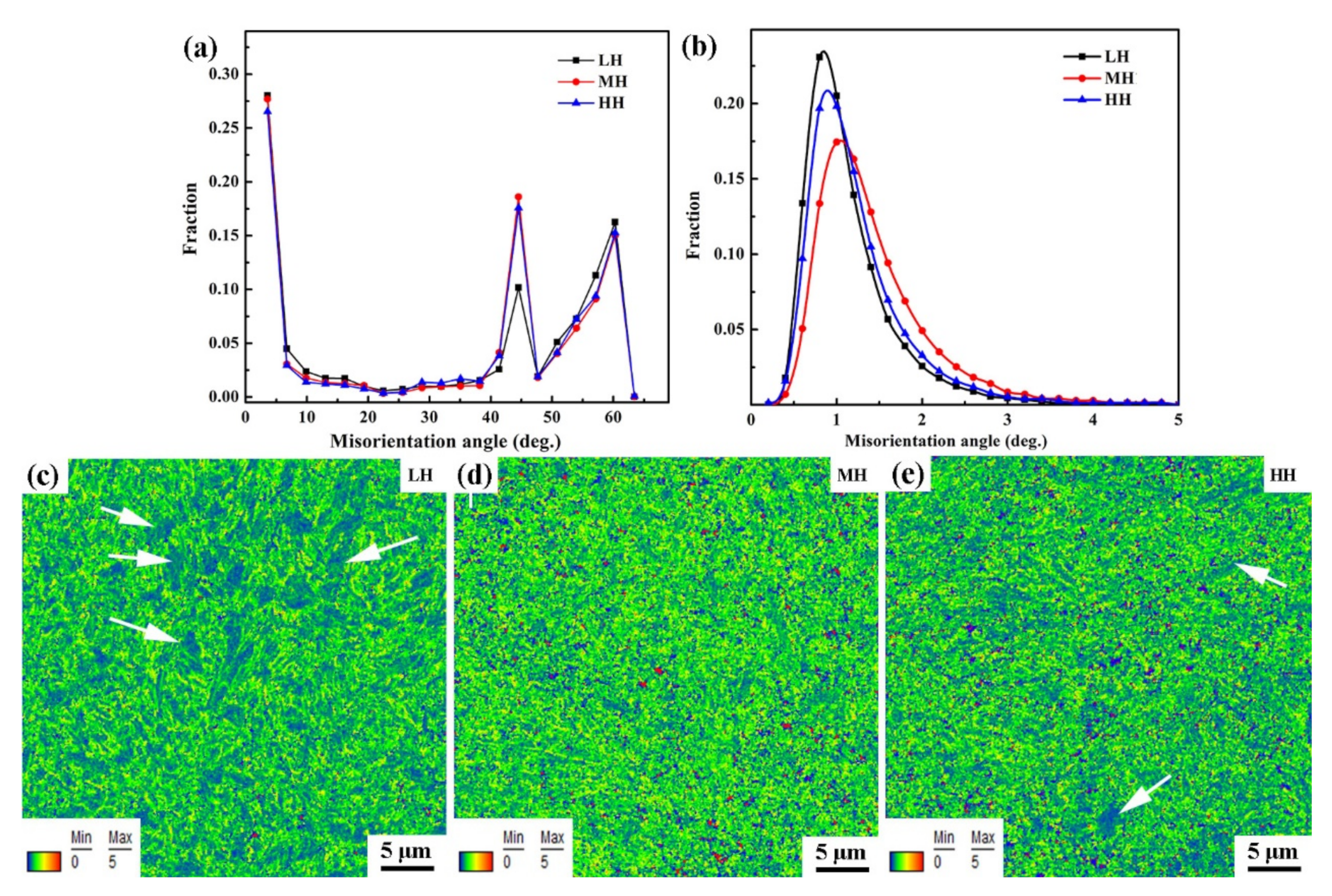
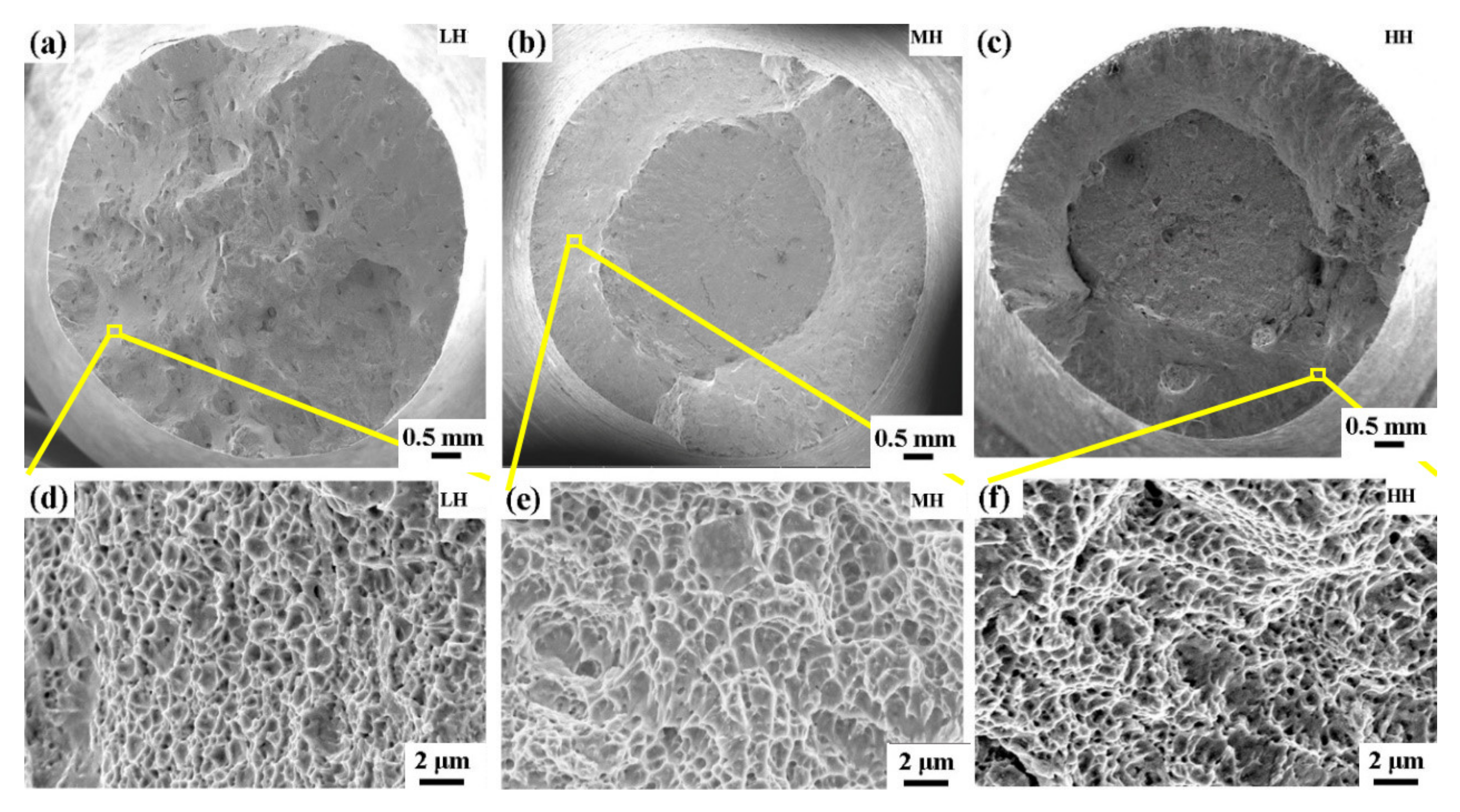
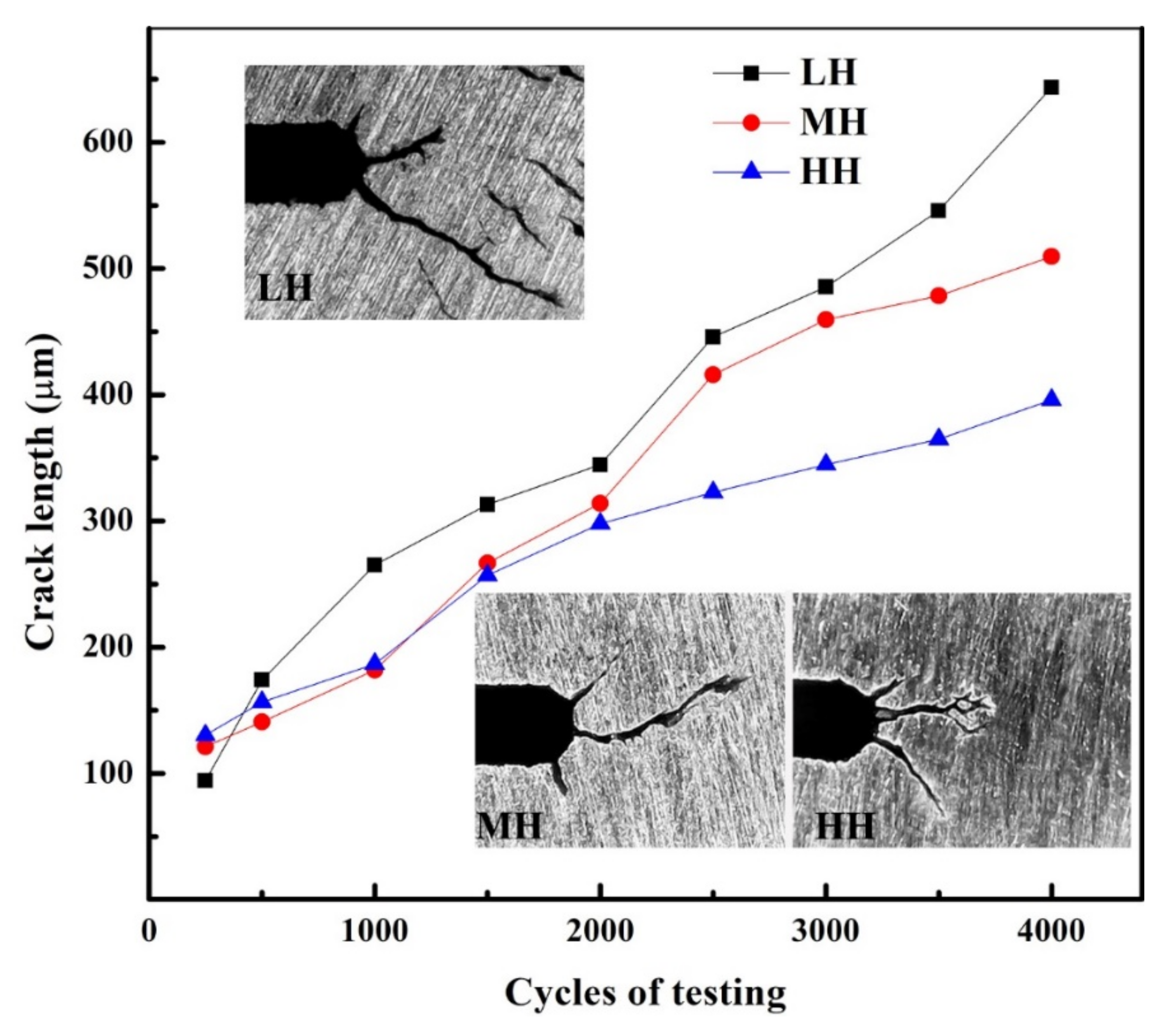
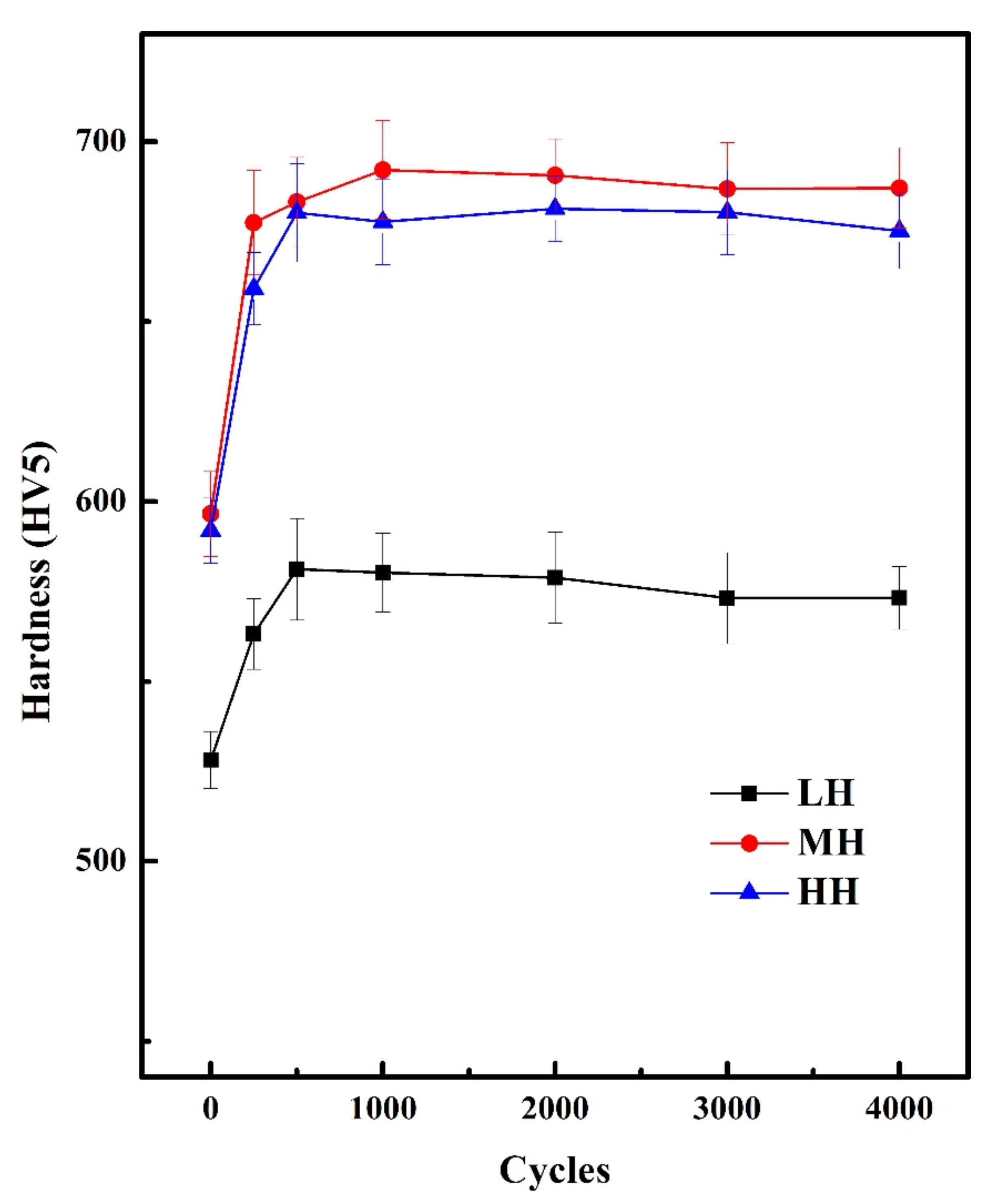

| Material Type | C | Cr | Mo | Si | V | Mn | Fe |
|---|---|---|---|---|---|---|---|
| LH | 0.34 | 4.77 | 0.89 | 0.94 | 0.54 | 0.48 | Bal. |
| MH | 0.37 | 5.05 | 1.32 | 1.11 | 1.07 | 0.49 | Bal. |
| HH | 0.36 | 5.72 | 1.47 | 1.08 | 1.07 | 0.68 | Bal. |
| Tolerance (±) | 0.005 | 0.035 | 0.024 | 0.020 | 0.020 | 0.015 |
| Material Type | Yield Strength (YS), MPa | Ultimate Tensile Strength (UTS), MPa | Total Elongation, % |
|---|---|---|---|
| LH | 1090 ± 31 | 1218 ± 18 | 7.7 ± 0.3 |
| MH | 1184 ± 26 | 1281 ± 19 | 7.1 ± 0.3 |
| HH | 1142 ± 10 | 1258 ± 22 | 8.6 ± 0.2 |
Publisher’s Note: MDPI stays neutral with regard to jurisdictional claims in published maps and institutional affiliations. |
© 2022 by the authors. Licensee MDPI, Basel, Switzerland. This article is an open access article distributed under the terms and conditions of the Creative Commons Attribution (CC BY) license (https://creativecommons.org/licenses/by/4.0/).
Share and Cite
Wang, M.; You, B.; Wu, Y.; Liang, B.; Gao, X.; Li, W.; Wei, Q. Effect of Cr, Mo, and V Elements on the Microstructure and Thermal Fatigue Properties of the Chromium Hot-Work Steels Processed by Selective Laser Melting. Metals 2022, 12, 735. https://doi.org/10.3390/met12050735
Wang M, You B, Wu Y, Liang B, Gao X, Li W, Wei Q. Effect of Cr, Mo, and V Elements on the Microstructure and Thermal Fatigue Properties of the Chromium Hot-Work Steels Processed by Selective Laser Melting. Metals. 2022; 12(5):735. https://doi.org/10.3390/met12050735
Chicago/Turabian StyleWang, Mei, Bo You, Yan Wu, Bo Liang, Xianhui Gao, Wei Li, and Qingsong Wei. 2022. "Effect of Cr, Mo, and V Elements on the Microstructure and Thermal Fatigue Properties of the Chromium Hot-Work Steels Processed by Selective Laser Melting" Metals 12, no. 5: 735. https://doi.org/10.3390/met12050735






